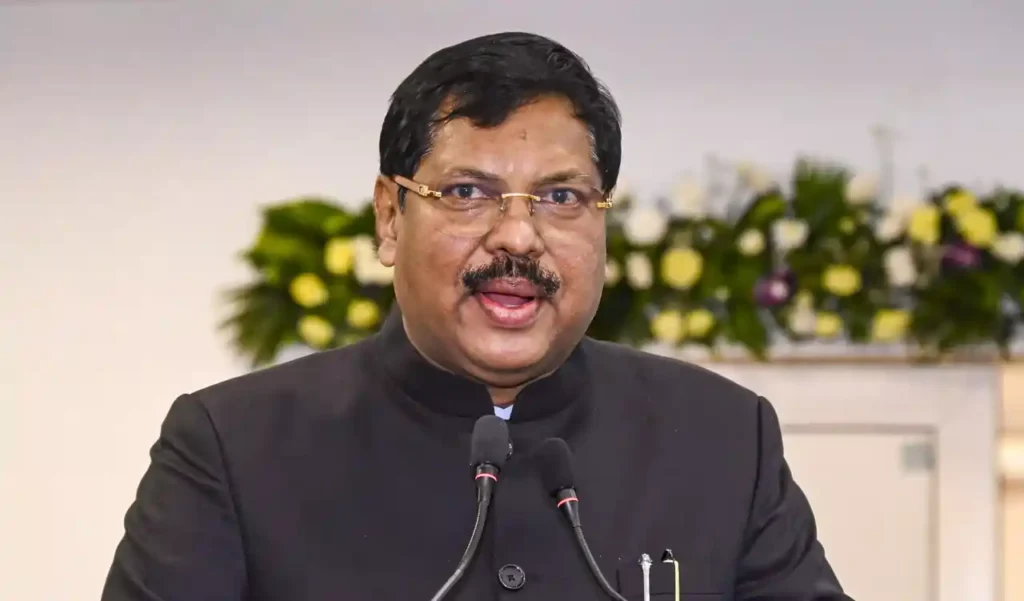New Delhi: Chief Justice of India (CJI) B R Gavai has underscored the pivotal role of technology in transforming the Indian legal system while emphasizing that it must complement, not replace, the human conscience in judicial decision-making. Speaking at the School of Oriental and African Studies (SOAS), University of London, on June 7, 2025, during his keynote address titled “Role of Technology in the Indian Legal System,” CJI Gavai highlighted the irreplaceable value of discretion, empathy, and judicial interpretation in delivering justice.

The Role of Technology in Indian Judiciary
India’s legal system is one of the largest and most complex in the world, handling thousands of cases daily across district courts, High Courts, and the Supreme Court. The Constitution empowers citizens through Article 32, which guarantees the right to approach the Supreme Court for fundamental rights enforcement, and Article 226, which grants High Courts extensive jurisdiction. District courts serve as the first instance for many cases, making efficient case management critical. CJI Gavai noted that managing such a voluminous docket poses significant challenges in ensuring timely and equitable justice delivery.
Technology has emerged as a transformative force in addressing these challenges. The judiciary has embraced innovations like automated cause lists, digital kiosks, and virtual assistants to streamline processes and enhance accessibility. However, CJI Gavai stressed that these tools must be implemented with human oversight, ethical guidelines, and robust training to maintain trust and transparency. “The emphasis must always be on using technology to enhance trust and transparency—never to replace the human conscience at the heart of justice,” he said.
Key Applications of Technology in the Judiciary
The Indian judiciary has adopted several cutting-edge technologies to improve efficiency and accessibility:
- Automated Case Management: Deep Learning and Machine Learning algorithms enable smart scheduling, case prioritization, and proactive backlog reduction, ensuring smoother court operations.
- Predictive Analysis: By analyzing historical judgments and case data, predictive tools offer insights to aid judicial processes, though human judgment remains paramount.
- Optical Character Recognition (OCR) and Natural Language Processing (NLP): These technologies facilitate document digitization, speeding up processing and minimizing errors.
- Blockchain Technology: Used to maintain judicial deposit registers and prevent record tampering, ensuring data integrity.
- AI-Chatbots: These provide real-time user assistance, offering procedural guidance, legal updates, and information to litigants and lawyers.
These applications have made courts more efficient and accessible, particularly during the COVID-19 pandemic, when virtual hearings became a necessity.
Key Initiatives to Integrate Technology
Several landmark initiatives have driven the integration of technology into the Indian judiciary:
- National Judicial Data Grid (NJDG): Part of the eCourts Project, NJDG creates a comprehensive database of orders, judgments, and cases, enhancing transparency and accessibility.
- Case Information Software (CIS): Based on customized Free and Open-Source Software (FOSS), CIS has been implemented in District Courts and High Courts to streamline case management.
- eCourts Mission Mode Project: Launched under the National eGovernance Plan, this project, overseen by the e-Committee of the Supreme Court and the Department of Justice, has progressed in three phases:
- Phase I (2011-2015): Focused on computerizing District Courts.
- Phase II (2015-2023): Designated High Courts as implementing agencies for projects under their jurisdiction.
- Phase III: Allocated Rs. 7,000 crores in the Union Budget (2023-2024) for further implementation, aiming to modernize judicial infrastructure.
The eCourts Project laid the foundation for digitizing routine processes like filing, listing, and accessing case status, making courts more accessible to the common citizen. During the COVID-19 pandemic, the judiciary’s swift transition to virtual hearings marked a watershed moment. Over 5.5 million cases were heard via video conferencing in 2020, positioning India as a global leader in digital court operations. Hybrid hearings have since become a permanent fixture, allowing litigants and lawyers to participate without traveling long distances, reducing costs, and democratizing access to justice.
Addressing the Digital Divide
Despite these advancements, CJI Gavai highlighted the significant challenge of the digital divide. Many litigants, particularly from rural areas, marginalized communities, and women, face barriers to accessing digital platforms. A 2023 survey by the Indigenous Navigator Community and the Women and Gender Research Centre revealed stark disparities in Jharkhand, a state with a significant tribal population. Over 65% of tribal communities lacked access to legal aid, 88% reported no culturally or linguistically appropriate education in public systems, and 77% noted the absence of tribal language content on state-run platforms.
These findings underscore the need for inclusive and equitable technological interventions. “Without proactive planning and targeted interventions, technology may create a two-tier system—one for the digitally connected and another for those left behind,” CJI Gavai cautioned. To address this, the Supreme Court launched the Supreme Court Vidhik Anuvaad Software (SUVAS), an AI-driven tool that translates judgments into various Indian languages, making judicial decisions accessible to a broader population. This initiative has inspired High Courts to adopt similar measures, breaking down language barriers in a linguistically diverse nation.
Challenges and Ethical Concerns
While technology offers immense potential, it also presents challenges that must be addressed:
- Bias in AI Algorithms: AI tools may produce biased results, leading to unfair or discriminatory decisions if not properly regulated.
- Data Security: Courts handle sensitive data, and breaches could undermine their integrity and public trust.
- Legitimacy and Authenticity: Concerns arise regarding the legitimacy of witnesses’ identities in virtual settings.
- Technical Malfunctions: Poor digital connectivity in rural areas can disrupt court operations, hindering access to justice.
CJI Gavai emphasized the global debates surrounding the ethical use of AI in legal systems, citing concerns like algorithmic bias, misinformation, data manipulation, and breaches of confidentiality. For instance, sensitive information, such as crime victims’ identities, must be protected from AI errors or inadequate protocols. Recent cases have shown that unregulated AI tools can generate fabricated citations or biased suggestions, necessitating robust monitoring.
To address these concerns, CJI Gavai initiated discussions with the Centre for Research and Planning of the Supreme Court in his first week as CJI to develop a comprehensive note on the ethical use of AI and emerging technologies in the judiciary. He stressed that the Indian judiciary is well-positioned to create homegrown ethical frameworks tailored to the country’s constitutional and societal realities, leveraging its technological expertise, judicial foresight, and democratic mandate.
Technology in Arbitration
In a separate address at a joint event by the Singapore International Arbitration Centre and Trilegal during London International Disputes Week, CJI Gavai discussed the evolving landscape of arbitration in India. He noted that justice delivery has shifted from adversarial courtroom battles to alternative dispute resolution mechanisms like arbitration, which offers confidentiality, expertise, and tailored solutions for complex commercial disputes.
India has made significant strides in becoming an arbitration-friendly jurisdiction over the past 10-15 years through legislative reforms and progressive Supreme Court judgments. However, challenges persist due to the country’s vast size and diversity. CJI Gavai emphasized that the judiciary respects the autonomy of the arbitral process, intervening only when necessary to uphold justice. He praised the 7th edition of the SIAC Rules for enhancing efficiency and fairness, presenting both an opportunity for India to align with global best practices and a challenge to balance international standards with local realities.
A People-Centric Vision for Justice
CJI Gavai concluded his SOAS address by reiterating that access to justice is a shared national commitment, not solely the judiciary’s responsibility. He called on law schools, civil society, legal aid institutions, and governments to collaborate in developing transparent, accessible, and inclusive technological models. “Our ultimate goal should be to make justice accessible to every citizen, regardless of language, geography, income, or digital literacy,” he said.
The CJI’s vision is rooted in constitutional values, emphasizing a people-centric approach guided by ethical clarity. By anchoring technology in constitutionalism and empathy, the judiciary aims to transform access to justice from an abstract ideal into a lived reality. The Indian judiciary’s progressive yet cautious embrace of technology reflects its commitment to equality, dignity, and justice for all.
Conclusion
CJI B R Gavai’s address highlights the transformative potential of technology in modernizing the Indian legal system while underscoring the irreplaceable role of human judgment. From automated case management to AI-driven translations, technology is enhancing efficiency and accessibility in the judiciary. However, challenges like bias, data security, and the digital divide require careful navigation. Through initiatives like the eCourts Project and NJDG, and a commitment to ethical frameworks, the Indian judiciary is paving the way for a more inclusive and transparent justice system. As India continues its journey toward modernization, CJI Gavai’s call for a balanced approach ensures that technology serves as a tool to empower, not overshadow, the human conscience at the heart of justice.
FAQs
1. How is technology being used to improve the Indian judicial system?
Technology is transforming the Indian judiciary through tools like automated case management (using Deep Learning and Machine Learning for smart scheduling and backlog reduction), predictive analysis of historical case data, Optical Character Recognition (OCR) and Natural Language Processing (NLP) for document digitization, blockchain for secure judicial records, and AI-chatbots for real-time user assistance. Initiatives like the National Judicial Data Grid (NJDG) and the eCourts Project enhance transparency and accessibility by digitizing case processes and enabling virtual hearings.
2. What is the eCourts Mission Mode Project, and what are its phases?
The eCourts Mission Mode Project, under the National eGovernance Plan, aims to modernize the Indian judiciary through technology. It is implemented by the e-Committee of the Supreme Court and the Department of Justice in three phases: Phase I (2011-2015) computerized District Courts; Phase II (2015-2023) empowered High Courts to manage projects under their jurisdiction; and Phase III, with Rs. 7,000 crores allocated in the 2023-2024 Union Budget, focuses on further infrastructure upgrades and digital integration.
3. What are the main challenges of integrating technology into the Indian judiciary?
Key challenges include AI algorithm bias, which may lead to unfair decisions, data security risks that could compromise sensitive judicial information, legitimacy concerns regarding witness identities in virtual settings, and technical malfunctions, particularly due to poor digital connectivity in rural areas. The digital divide also poses a barrier, with many rural and marginalized communities lacking access to digital platforms, as highlighted by a 2023 survey in Jharkhand.
4. How is the Indian judiciary addressing the digital divide?
To bridge the digital divide, the Supreme Court launched the Supreme Court Vidhik Anuvaad Software (SUVAS), an AI-driven tool that translates judgments into various Indian languages, making them accessible to a broader population. High Courts are following suit with similar initiatives. Chief Justice of India B R Gavai emphasized proactive planning to ensure technology does not create a two-tier system, advocating for inclusive and equitable access to justice.
5. Why does CJI B R Gavai stress that technology should not replace human judgment?
CJI B R Gavai emphasizes that technology must complement, not replace, human judgment because complex legal issues require discretion, empathy, and nuanced interpretation that AI cannot fully replicate. He underscores that human oversight, ethical guidelines, and robust training are essential to prevent issues like algorithmic bias, misinformation, or breaches of confidentiality, ensuring technology enhances trust and transparency while preserving the human conscience at the heart of justice.

